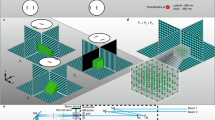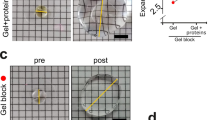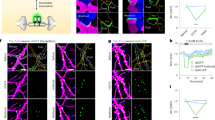Abstract
The plasticity of excitatory synapses has conventionally been studied from a functional perspective. Recent advances in neuronal imaging techniques have made it possible to study another aspect, the plasticity of the synaptic structure. This takes place at the dendritic spines, where most excitatory synapses are located. Actin is the most abundant cytoskeletal component in dendritic spines, and thus the most plausible site of regulation. The mechanism by which actin is regulated has not been characterized because of the lack of a specific method for detection of the polymerization status of actin in such a small subcellular structure. Here we describe an optical approach that allows us to monitor F-actin and G-actin equilibrium in living cells through the use of two-photon microscopy to observe fluorescence resonance energy transfer (FRET) between actin monomers. Our protocol provides the first direct method for looking at the dynamic equilibrium between F-actin and G-actin in intact cells.
This is a preview of subscription content, access via your institution
Access options
Subscribe to this journal
Receive 12 print issues and online access
$259.00 per year
only $21.58 per issue
Buy this article
- Purchase on Springer Link
- Instant access to full article PDF
Prices may be subject to local taxes which are calculated during checkout






Similar content being viewed by others
References
Sheng, M. & Pak, D.T. Ligand-gated ion channel interactions with cytoskeletal and signaling proteins. Annu. Rev. Physiol. 62, 755–778 (2000).
Okamoto, K., Nagai, T., Miyawaki, A. & Hayashi, Y. Rapid and persistent modulation of actin dynamics regulates postsynaptic reorganization underlying bidirectional plasticity. Nat. Neurosci. 7, 1104–1112 (2004).
Matsuzaki, M., Honkura, N., Ellis-Davies, G.C. & Kasai, H. Structural basis of long-term potentiation in single dendritic spines. Nature 429, 761–766 (2004).
Hayashi, Y. & Majewska, A.K. Dendritic spine geometry: functional implication and regulation. Neuron 46, 529–532 (2005).
Zhou, Q., Homma, K.J. & Poo, M.M. Shrinkage of dendritic spines associated with long-term depression of hippocampal synapses. Neuron 44, 749–757 (2004).
Nägerl, U.V., Eberhorn, N., Cambridge, S.B. & Bonhoeffer, T. Bidirectional activity-dependent morphological plasticity in hippocampal neurons. Neuron 44, 759–767 (2004).
Blomberg, F., Cohen, R.S. & Siekevitz, P. The structure of postsynaptic densities isolated from dog cerebral cortex. II. Characterization and arrangement of some of the major proteins within the structure. J. Cell Biol. 74, 204–225 (1977).
Lisman, J. Actin's actions in LTP-induced synapse growth. Neuron 38, 361–362 (2003).
Fifková, E. & Morales, M. Actin matrix of dendritic spines, synaptic plasticity, and long-term potentiation. Int. Rev. Cytol. 139, 267–307 (1992).
Matus, A. Actin-based plasticity in dendritic spines. Science 290, 754–758 (2000).
Colicos, M.A., Collins, B.E., Sailor, M.J. & Goda, Y. Remodeling of synaptic actin induced by photoconductive stimulation. Cell 107, 605–616 (2001).
Hering, H. & Sheng, M. Activity-dependent redistribution and essential role of cortactin in dendritic spine morphogenesis. J. Neurosci. 23, 11759–11769 (2003).
Fukazawa, Y. et al. Hippocampal LTP is accompanied by enhanced F-actin content within the dendritic spine that is essential for late LTP maintenance in vivo. Neuron 38, 447–460 (2003).
Halpain, S., Hipolito, A. & Saffer, L. Regulation of F-actin stability in dendritic spines by glutamate receptors and calcineurin. J. Neurosci. 18, 9835–9844 (1998).
Furuyashiki, T., Arakawa, Y., Takemoto-Kimura, S., Bito, H. & Narumiya, S. Multiple spatiotemporal modes of actin reorganization by NMDA receptors and voltage-gated Ca2+ channels. Proc. Natl. Acad. Sci. USA 99, 14458–14463 (2002).
Furukawa, K. et al. The actin-severing protein gelsolin modulates calcium channel and NMDA receptor activities and vulnerability to excitotoxicity in hippocampal neurons. J. Neurosci. 17, 8178–8186 (1997).
Star, E.N., Kwiatkowski, D.J. & Murthy, V.N. Rapid turnover of actin in dendritic spines and its regulation by activity. Nat. Neurosci. 5, 239–246 (2002).
Wang, Y.L. & Taylor, D.L. Probing the dynamic equilibrium of actin polymerization by fluorescence energy transfer. Cell 27, 429–436 (1981).
Taylor, D.L., Reidler, J., Spudich, J.A. & Stryer, L. Detection of actin assembly by fluorescence energy transfer. J. Cell Biol. 89, 362–367 (1981).
Miyawaki, A. et al. Fluorescent indicators for Ca2+ based on green fluorescent proteins and calmodulin. Nature 388, 882–887 (1997).
Giepmans, B.N., Adams, S.R., Ellisman, M.H. & Tsien, R.Y. The fluorescent toolbox for assessing protein location and function. Science 312, 217–224 (2006).
Stoppini, L., Buchs, P.A. & Muller, D. A simple method for organotypic cultures of nervous tissue. J. Neurosci. Methods 37, 173–182 (1991).
Shi, S.H. et al. Rapid spine delivery and redistribution of AMPA receptors after synaptic NMDA receptor activation. Science 284, 1811–1816 (1999).
Lo, D.C., McAllister, A.K. & Katz, L.C. Neuronal transfection in brain slices using particle-mediated gene transfer. Neuron 13, 1263–1268 (1994).
Arnold, D., Feng, L., Kim, J. & Heintz, N. A strategy for the analysis of gene expression during neural development. Proc. Natl. Acad. Sci. USA 91, 9970–9974 (1994).
Hayashi, Y. et al. Driving AMPA receptors into synapses by LTP and CaMKII: requirement for GluR1 and PDZ domain interaction. Science 287, 2262–2267 (2000).
Miyawaki, A. Innovations in the imaging of brain functions using fluorescent proteins. Neuron 48, 189–199 (2005).
Campbell, R.E. et al. A monomeric red fluorescent protein. Proc. Natl. Acad. Sci. USA 99, 7877–7882 (2002).
Shaner, N.C. et al. Improved monomeric red, orange and yellow fluorescent proteins derived from Discosoma sp. red fluorescent protein. Nat. Biotechnol. 22, 1567–1572 (2004).
Vanderklish, P.W. et al. Marking synaptic activity in dendritic spines with a calpain substrate exhibiting fluorescence resonance energy transfer. Proc. Natl. Acad. Sci. USA 97, 2253–2258 (2000).
Takao, K. et al. Visualization of synaptic Ca2+/calmodulin-dependent protein kinase II activity in living neurons. J. Neurosci. 25, 3107–3112 (2005).
Denk, W., Strickler, J.H. & Webb, W.W. Two-photon laser scanning fluorescence microscopy. Science 248, 73–76 (1990).
Denk, W. & Svoboda, K. Photon upmanship: why multiphoton imaging is more than a gimmick. Neuron 18, 351–357 (1997).
Mainen, Z.F. et al. Two-photon imaging in living brain slices. Methods 18, 231–239 181 (1999).
Nagai, T. et al. A variant of yellow fluorescent protein with fast and efficient maturation for cell-biological applications. Nat. Biotechnol. 20, 87–90 (2002).
Matsuzaki, M. et al. Dendritic spine geometry is critical for AMPA receptor expression in hippocampal CA1 pyramidal neurons. Nat. Neurosci. 4, 1086–1092 (2001).
Acknowledgements
We thank T. Nagai and A. Miyawaki for discussions and sharing resources, S.M. Kwok for sharing spectral data of CFP-actin and YFP-actin and M. Churchill and T. Emery for editing. Supported by RIKEN, The Ellison Medical Foundation and a National Institutes of Health R01 grant (DA017310-01A1) to Y.H.
Author information
Authors and Affiliations
Corresponding author
Ethics declarations
Competing interests
The authors declare no competing financial interests.
Rights and permissions
About this article
Cite this article
Okamoto, KI., Hayashi, Y. Visualization of F-actin and G-actin equilibrium using fluorescence resonance energy transfer (FRET) in cultured cells and neurons in slices. Nat Protoc 1, 911–919 (2006). https://doi.org/10.1038/nprot.2006.122
Published:
Issue Date:
DOI: https://doi.org/10.1038/nprot.2006.122
This article is cited by
-
Fluorescence resonance energy transfer microscopy as demonstrated by measuring the activation of the serine/threonine kinase Akt
Nature Protocols (2013)
-
Chronic Alcohol Alters Dendritic Spine Development in Neurons in Primary Culture
Neurotoxicity Research (2013)
-
Catching the engram: strategies to examine the memory trace
Molecular Brain (2012)
Comments
By submitting a comment you agree to abide by our Terms and Community Guidelines. If you find something abusive or that does not comply with our terms or guidelines please flag it as inappropriate.



